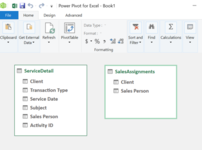I am using a DISTINCOUNT measure to count (for a team of sales people) the number of distinct customers who have made purchases.
I'd like to expand on this to count only the number of distinct customers who have made more than 3 purchases. How can something like this be achieved?
I know that I can just set the criteria in the pivot table field settings, but this won't let me do other things like time intelligence functions based on the value. Many thanks.
I'd like to expand on this to count only the number of distinct customers who have made more than 3 purchases. How can something like this be achieved?
I know that I can just set the criteria in the pivot table field settings, but this won't let me do other things like time intelligence functions based on the value. Many thanks.






